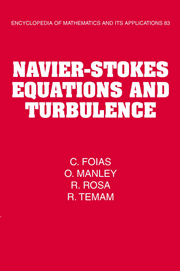Book contents
- Frontmatter
- Contents
- Preface
- Acknowledgments
- Chapter I Introduction and Overview of Turbulence
- Chapter II Elements of the Mathematical Theory of the Navier–Stokes Equations
- Chapter III Finite Dimensionality of Flows
- Chapter IV Stationary Statistical Solutions of the Navier–Stokes Equations, Time Averages, and Attractors
- Chapter V Time-Dependent Statistical Solutions of the Navier–Stokes Equations and Fully Developed Turbulence
- References
- Index
Chapter I - Introduction and Overview of Turbulence
Published online by Cambridge University Press: 14 August 2009
- Frontmatter
- Contents
- Preface
- Acknowledgments
- Chapter I Introduction and Overview of Turbulence
- Chapter II Elements of the Mathematical Theory of the Navier–Stokes Equations
- Chapter III Finite Dimensionality of Flows
- Chapter IV Stationary Statistical Solutions of the Navier–Stokes Equations, Time Averages, and Attractors
- Chapter V Time-Dependent Statistical Solutions of the Navier–Stokes Equations and Fully Developed Turbulence
- References
- Index
Summary
Introduction
In this chapter we first briefly recall, in Section 1, the derivation of the Navier–Stokes equations (NSE) starting from the basic conservation principles in mechanics: conservation of mass and momentum. Section 2 contains some general remarks on turbulence, and it alludes to some developments not presented in the book. For the benefit of the mathematically oriented reader (and perhaps others), Section 3 provides a fairly detailed account of the Kolmogorov theory of turbulence, which underlies many parts of Chapters III–V. For the physics-oriented reader, Section 4 gives an intuitive introduction to the mathematical perspective and the necessary tools. A more rigorous presentation appears in the first half of Chapter II and thereafter as needed. For each of the aspects that we develop, the present chapter should prove more useful for the nonspecialist than for the specialist.
Viscous Fluids. The Navier–Stokes Equations
Fluids obey the general laws of continuum mechanics: conservation of mass, energy, and linear momentum. They can be written as mathematical equations once a representation for the state of a fluid is chosen. In the context of mathematics, there are two classical representations. One is the so-called Lagrangian representation, where the state of a fluid “particle” at a given time is described with reference to its initial position.
- Type
- Chapter
- Information
- Navier-Stokes Equations and Turbulence , pp. 1 - 24Publisher: Cambridge University PressPrint publication year: 2001



